Coaching and Mentoring: Definitions, Responsibilities and Strategies
VerifiedAdded on 2023/06/11
|14
|3398
|392
Essay
AI Summary
This essay provides a detailed exploration of coaching and mentoring, beginning with the challenges in defining these terms and distinguishing between them. It highlights the similarities and differences, focusing on the roles, responsibilities, and effectiveness of coaches and mentors. The essay fu...
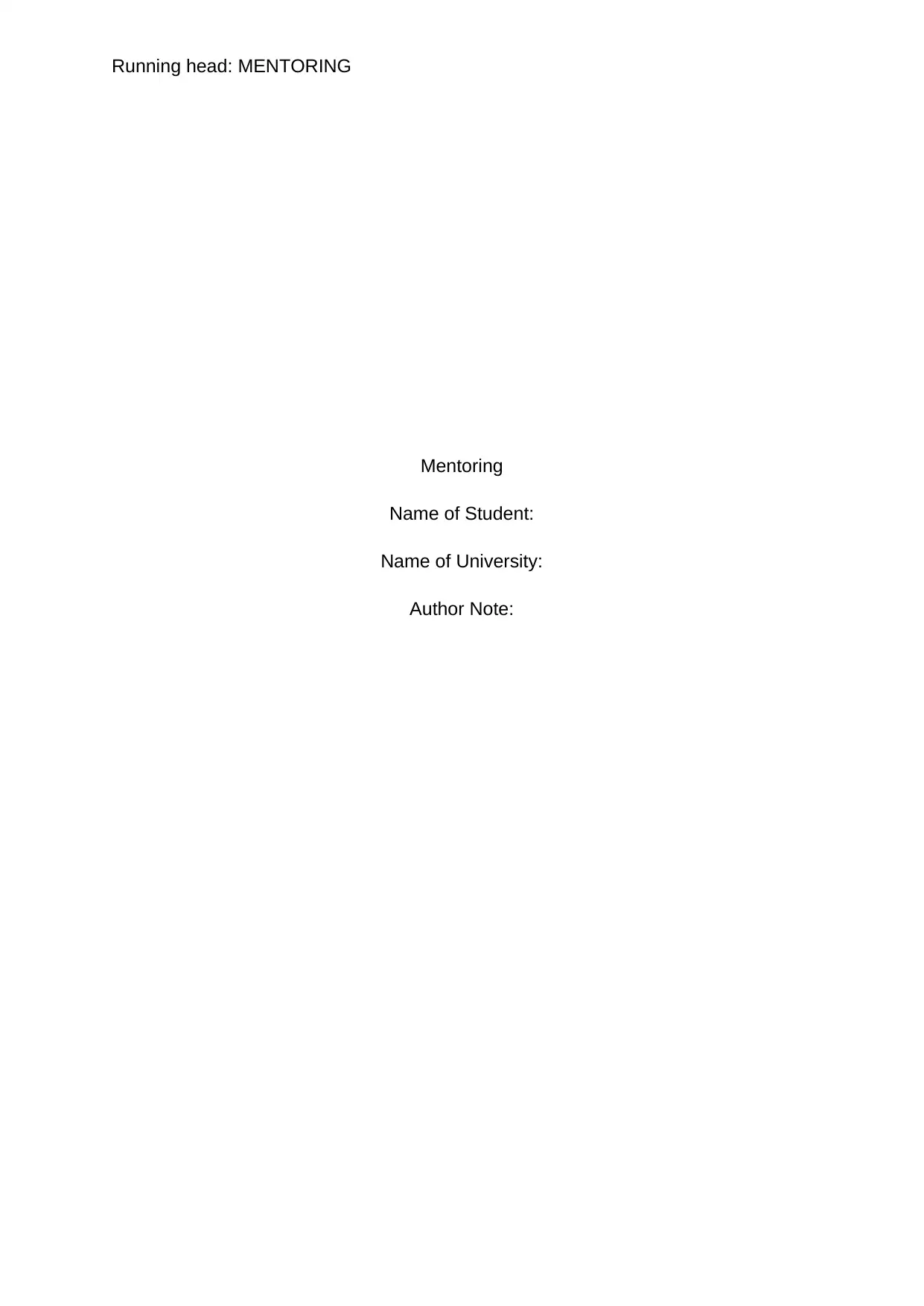
Running head: MENTORING
Mentoring
Name of Student:
Name of University:
Author Note:
Mentoring
Name of Student:
Name of University:
Author Note:
Paraphrase This Document
Need a fresh take? Get an instant paraphrase of this document with our AI Paraphraser
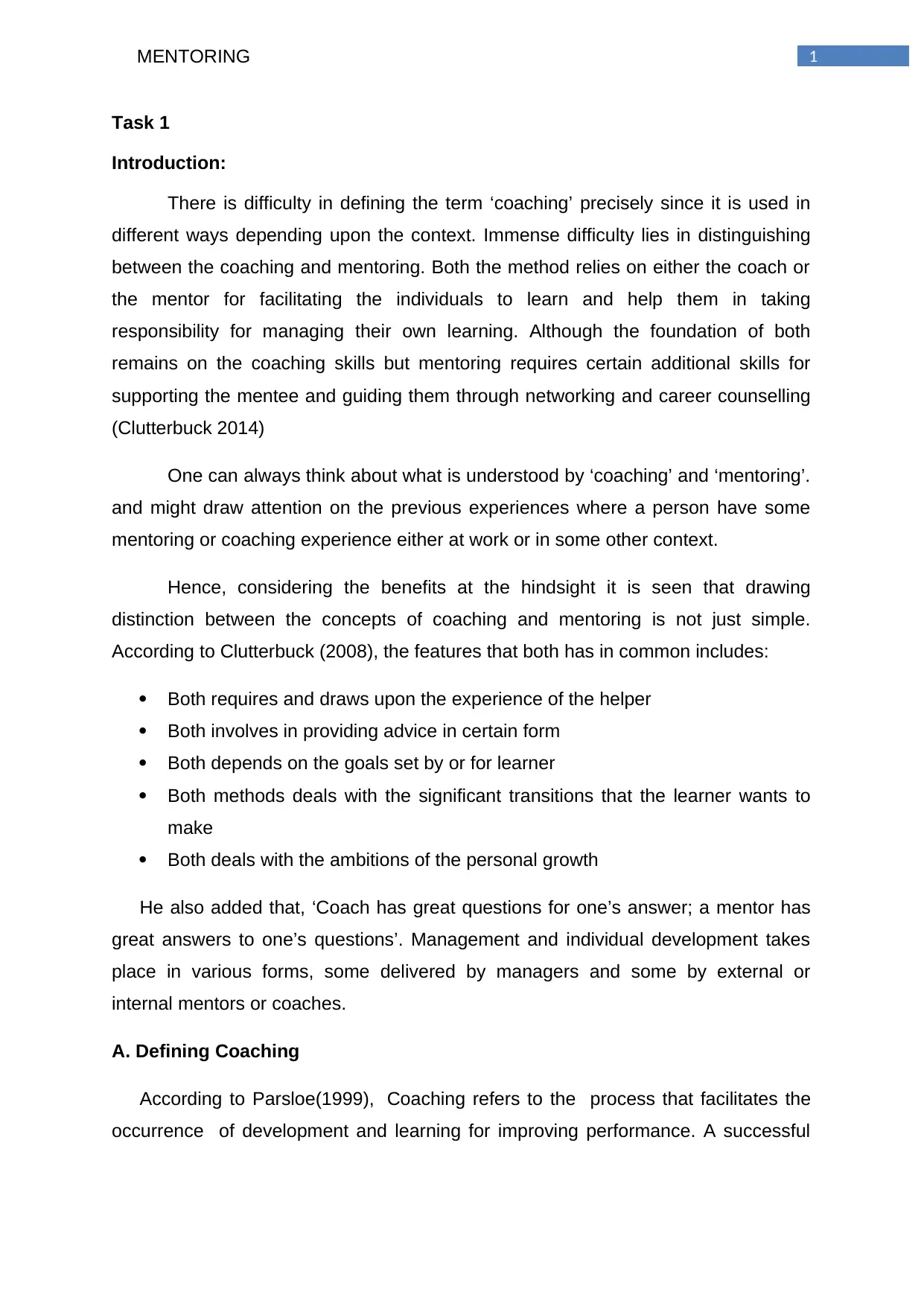
1MENTORING
Task 1
Introduction:
There is difficulty in defining the term ‘coaching’ precisely since it is used in
different ways depending upon the context. Immense difficulty lies in distinguishing
between the coaching and mentoring. Both the method relies on either the coach or
the mentor for facilitating the individuals to learn and help them in taking
responsibility for managing their own learning. Although the foundation of both
remains on the coaching skills but mentoring requires certain additional skills for
supporting the mentee and guiding them through networking and career counselling
(Clutterbuck 2014)
One can always think about what is understood by ‘coaching’ and ‘mentoring’.
and might draw attention on the previous experiences where a person have some
mentoring or coaching experience either at work or in some other context.
Hence, considering the benefits at the hindsight it is seen that drawing
distinction between the concepts of coaching and mentoring is not just simple.
According to Clutterbuck (2008), the features that both has in common includes:
Both requires and draws upon the experience of the helper
Both involves in providing advice in certain form
Both depends on the goals set by or for learner
Both methods deals with the significant transitions that the learner wants to
make
Both deals with the ambitions of the personal growth
He also added that, ‘Coach has great questions for one’s answer; a mentor has
great answers to one’s questions’. Management and individual development takes
place in various forms, some delivered by managers and some by external or
internal mentors or coaches.
A. Defining Coaching
According to Parsloe(1999), Coaching refers to the process that facilitates the
occurrence of development and learning for improving performance. A successful
Task 1
Introduction:
There is difficulty in defining the term ‘coaching’ precisely since it is used in
different ways depending upon the context. Immense difficulty lies in distinguishing
between the coaching and mentoring. Both the method relies on either the coach or
the mentor for facilitating the individuals to learn and help them in taking
responsibility for managing their own learning. Although the foundation of both
remains on the coaching skills but mentoring requires certain additional skills for
supporting the mentee and guiding them through networking and career counselling
(Clutterbuck 2014)
One can always think about what is understood by ‘coaching’ and ‘mentoring’.
and might draw attention on the previous experiences where a person have some
mentoring or coaching experience either at work or in some other context.
Hence, considering the benefits at the hindsight it is seen that drawing
distinction between the concepts of coaching and mentoring is not just simple.
According to Clutterbuck (2008), the features that both has in common includes:
Both requires and draws upon the experience of the helper
Both involves in providing advice in certain form
Both depends on the goals set by or for learner
Both methods deals with the significant transitions that the learner wants to
make
Both deals with the ambitions of the personal growth
He also added that, ‘Coach has great questions for one’s answer; a mentor has
great answers to one’s questions’. Management and individual development takes
place in various forms, some delivered by managers and some by external or
internal mentors or coaches.
A. Defining Coaching
According to Parsloe(1999), Coaching refers to the process that facilitates the
occurrence of development and learning for improving performance. A successful
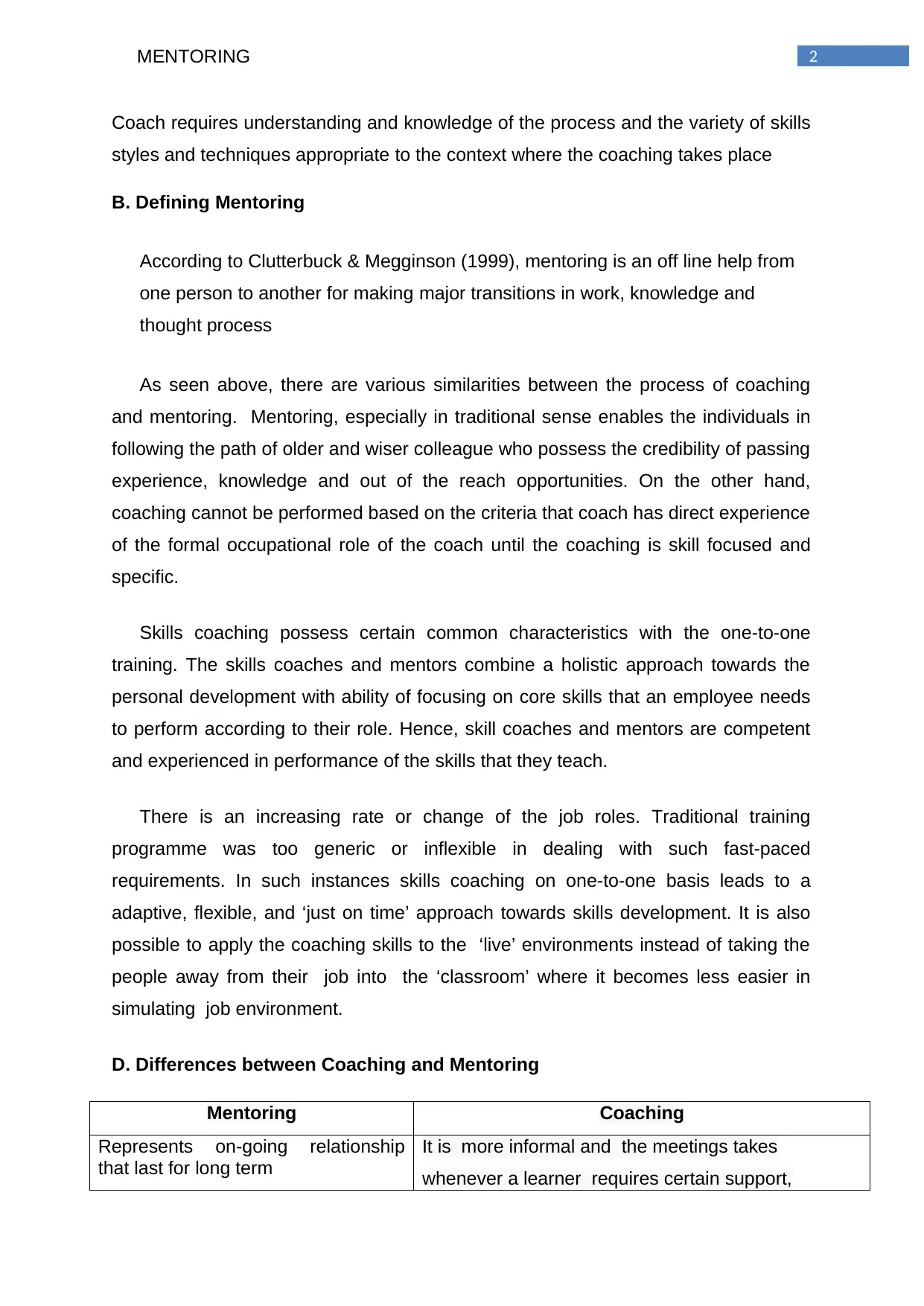
2MENTORING
Coach requires understanding and knowledge of the process and the variety of skills
styles and techniques appropriate to the context where the coaching takes place
B. Defining Mentoring
According to Clutterbuck & Megginson (1999), mentoring is an off line help from
one person to another for making major transitions in work, knowledge and
thought process
As seen above, there are various similarities between the process of coaching
and mentoring. Mentoring, especially in traditional sense enables the individuals in
following the path of older and wiser colleague who possess the credibility of passing
experience, knowledge and out of the reach opportunities. On the other hand,
coaching cannot be performed based on the criteria that coach has direct experience
of the formal occupational role of the coach until the coaching is skill focused and
specific.
Skills coaching possess certain common characteristics with the one-to-one
training. The skills coaches and mentors combine a holistic approach towards the
personal development with ability of focusing on core skills that an employee needs
to perform according to their role. Hence, skill coaches and mentors are competent
and experienced in performance of the skills that they teach.
There is an increasing rate or change of the job roles. Traditional training
programme was too generic or inflexible in dealing with such fast-paced
requirements. In such instances skills coaching on one-to-one basis leads to a
adaptive, flexible, and ‘just on time’ approach towards skills development. It is also
possible to apply the coaching skills to the ‘live’ environments instead of taking the
people away from their job into the ‘classroom’ where it becomes less easier in
simulating job environment.
D. Differences between Coaching and Mentoring
Mentoring Coaching
Represents on-going relationship
that last for long term
It is more informal and the meetings takes
whenever a learner requires certain support,
Coach requires understanding and knowledge of the process and the variety of skills
styles and techniques appropriate to the context where the coaching takes place
B. Defining Mentoring
According to Clutterbuck & Megginson (1999), mentoring is an off line help from
one person to another for making major transitions in work, knowledge and
thought process
As seen above, there are various similarities between the process of coaching
and mentoring. Mentoring, especially in traditional sense enables the individuals in
following the path of older and wiser colleague who possess the credibility of passing
experience, knowledge and out of the reach opportunities. On the other hand,
coaching cannot be performed based on the criteria that coach has direct experience
of the formal occupational role of the coach until the coaching is skill focused and
specific.
Skills coaching possess certain common characteristics with the one-to-one
training. The skills coaches and mentors combine a holistic approach towards the
personal development with ability of focusing on core skills that an employee needs
to perform according to their role. Hence, skill coaches and mentors are competent
and experienced in performance of the skills that they teach.
There is an increasing rate or change of the job roles. Traditional training
programme was too generic or inflexible in dealing with such fast-paced
requirements. In such instances skills coaching on one-to-one basis leads to a
adaptive, flexible, and ‘just on time’ approach towards skills development. It is also
possible to apply the coaching skills to the ‘live’ environments instead of taking the
people away from their job into the ‘classroom’ where it becomes less easier in
simulating job environment.
D. Differences between Coaching and Mentoring
Mentoring Coaching
Represents on-going relationship
that last for long term
It is more informal and the meetings takes
whenever a learner requires certain support,
⊘ This is a preview!⊘
Do you want full access?
Subscribe today to unlock all pages.

Trusted by 1+ million students worldwide
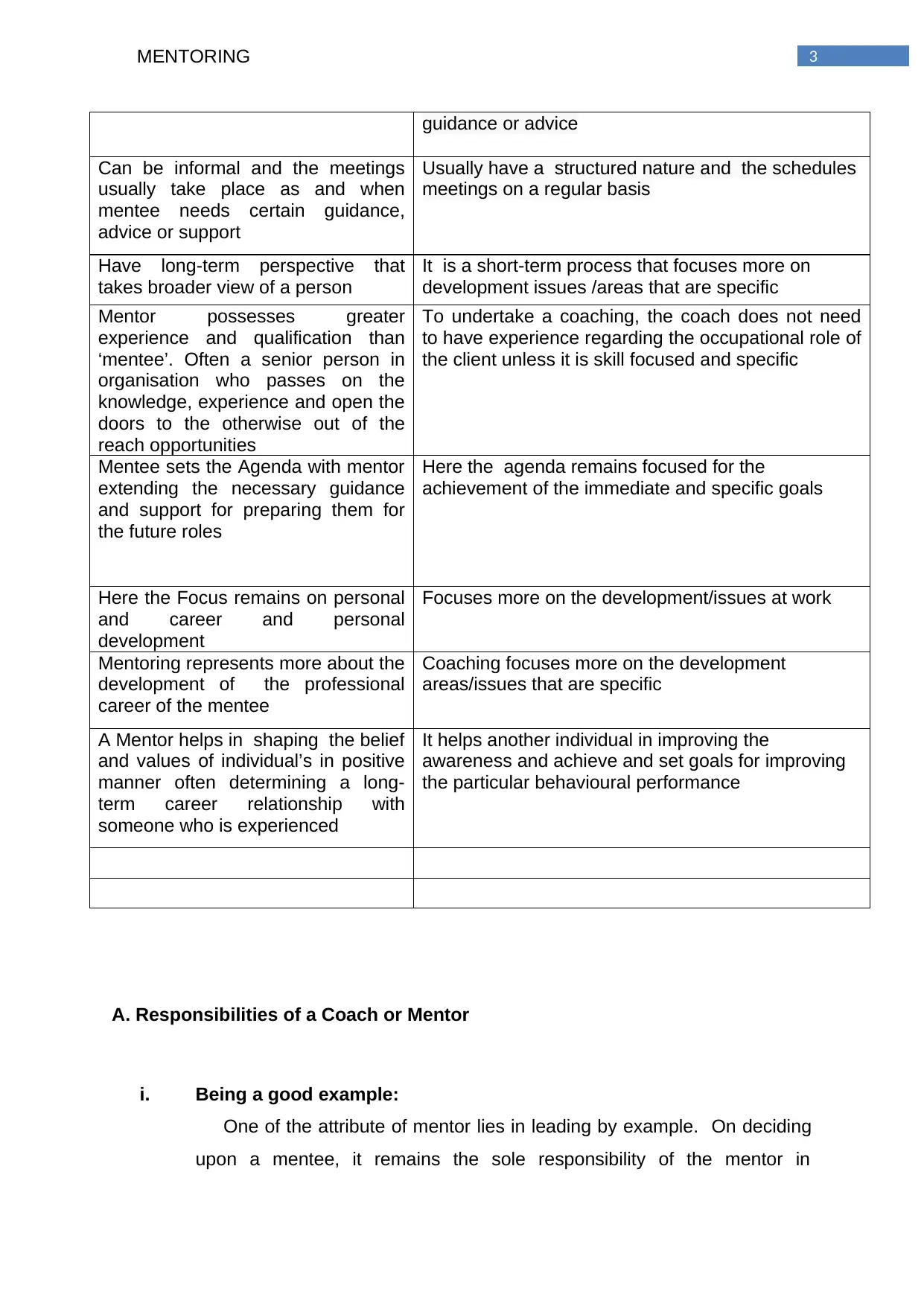
3MENTORING
guidance or advice
Can be informal and the meetings
usually take place as and when
mentee needs certain guidance,
advice or support
Usually have a structured nature and the schedules
meetings on a regular basis
Have long-term perspective that
takes broader view of a person
It is a short-term process that focuses more on
development issues /areas that are specific
Mentor possesses greater
experience and qualification than
‘mentee’. Often a senior person in
organisation who passes on the
knowledge, experience and open the
doors to the otherwise out of the
reach opportunities
To undertake a coaching, the coach does not need
to have experience regarding the occupational role of
the client unless it is skill focused and specific
Mentee sets the Agenda with mentor
extending the necessary guidance
and support for preparing them for
the future roles
Here the agenda remains focused for the
achievement of the immediate and specific goals
Here the Focus remains on personal
and career and personal
development
Focuses more on the development/issues at work
Mentoring represents more about the
development of the professional
career of the mentee
Coaching focuses more on the development
areas/issues that are specific
A Mentor helps in shaping the belief
and values of individual’s in positive
manner often determining a long-
term career relationship with
someone who is experienced
It helps another individual in improving the
awareness and achieve and set goals for improving
the particular behavioural performance
A. Responsibilities of a Coach or Mentor
i. Being a good example:
One of the attribute of mentor lies in leading by example. On deciding
upon a mentee, it remains the sole responsibility of the mentor in
guidance or advice
Can be informal and the meetings
usually take place as and when
mentee needs certain guidance,
advice or support
Usually have a structured nature and the schedules
meetings on a regular basis
Have long-term perspective that
takes broader view of a person
It is a short-term process that focuses more on
development issues /areas that are specific
Mentor possesses greater
experience and qualification than
‘mentee’. Often a senior person in
organisation who passes on the
knowledge, experience and open the
doors to the otherwise out of the
reach opportunities
To undertake a coaching, the coach does not need
to have experience regarding the occupational role of
the client unless it is skill focused and specific
Mentee sets the Agenda with mentor
extending the necessary guidance
and support for preparing them for
the future roles
Here the agenda remains focused for the
achievement of the immediate and specific goals
Here the Focus remains on personal
and career and personal
development
Focuses more on the development/issues at work
Mentoring represents more about the
development of the professional
career of the mentee
Coaching focuses more on the development
areas/issues that are specific
A Mentor helps in shaping the belief
and values of individual’s in positive
manner often determining a long-
term career relationship with
someone who is experienced
It helps another individual in improving the
awareness and achieve and set goals for improving
the particular behavioural performance
A. Responsibilities of a Coach or Mentor
i. Being a good example:
One of the attribute of mentor lies in leading by example. On deciding
upon a mentee, it remains the sole responsibility of the mentor in
Paraphrase This Document
Need a fresh take? Get an instant paraphrase of this document with our AI Paraphraser
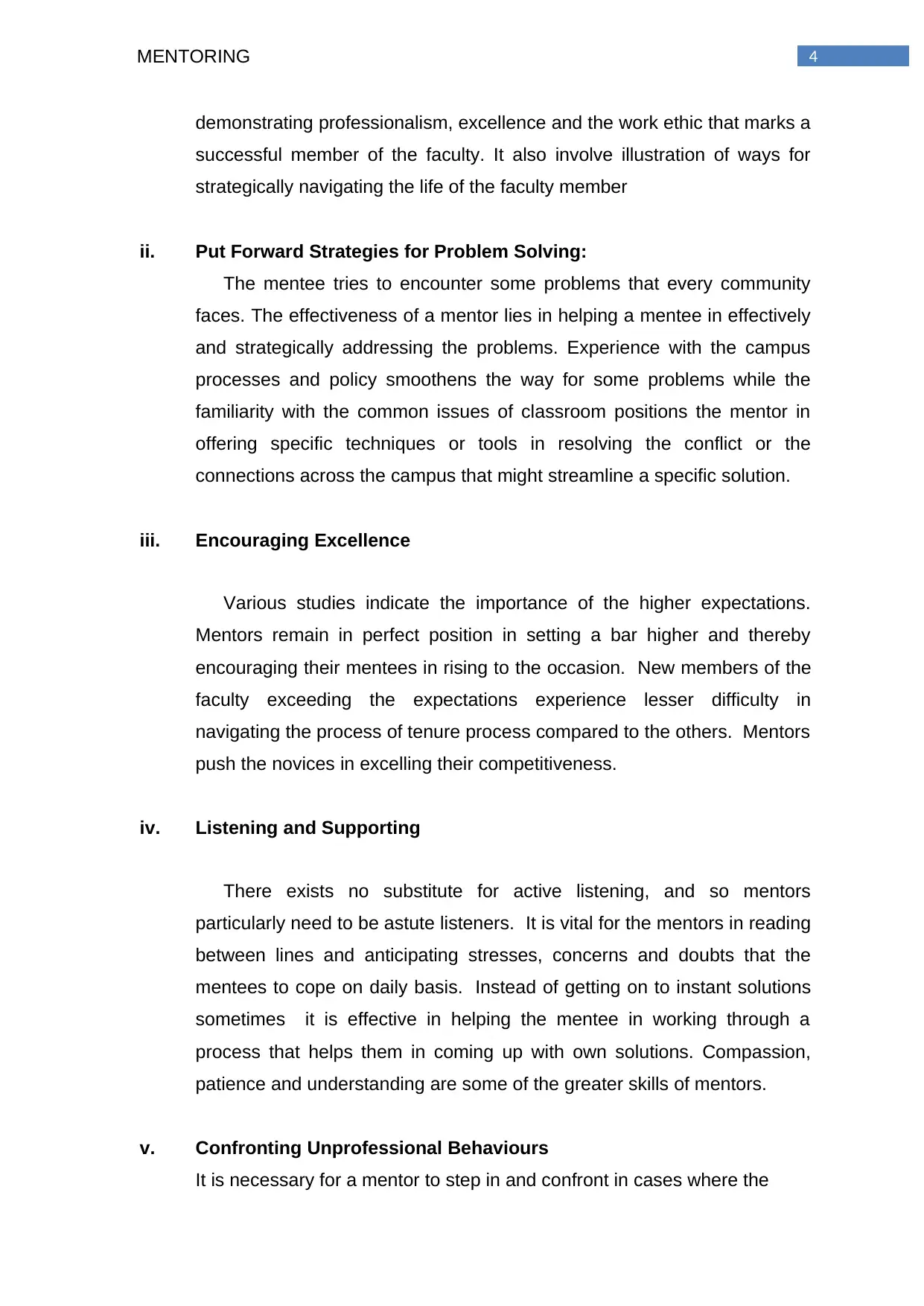
4MENTORING
demonstrating professionalism, excellence and the work ethic that marks a
successful member of the faculty. It also involve illustration of ways for
strategically navigating the life of the faculty member
ii. Put Forward Strategies for Problem Solving:
The mentee tries to encounter some problems that every community
faces. The effectiveness of a mentor lies in helping a mentee in effectively
and strategically addressing the problems. Experience with the campus
processes and policy smoothens the way for some problems while the
familiarity with the common issues of classroom positions the mentor in
offering specific techniques or tools in resolving the conflict or the
connections across the campus that might streamline a specific solution.
iii. Encouraging Excellence
Various studies indicate the importance of the higher expectations.
Mentors remain in perfect position in setting a bar higher and thereby
encouraging their mentees in rising to the occasion. New members of the
faculty exceeding the expectations experience lesser difficulty in
navigating the process of tenure process compared to the others. Mentors
push the novices in excelling their competitiveness.
iv. Listening and Supporting
There exists no substitute for active listening, and so mentors
particularly need to be astute listeners. It is vital for the mentors in reading
between lines and anticipating stresses, concerns and doubts that the
mentees to cope on daily basis. Instead of getting on to instant solutions
sometimes it is effective in helping the mentee in working through a
process that helps them in coming up with own solutions. Compassion,
patience and understanding are some of the greater skills of mentors.
v. Confronting Unprofessional Behaviours
It is necessary for a mentor to step in and confront in cases where the
demonstrating professionalism, excellence and the work ethic that marks a
successful member of the faculty. It also involve illustration of ways for
strategically navigating the life of the faculty member
ii. Put Forward Strategies for Problem Solving:
The mentee tries to encounter some problems that every community
faces. The effectiveness of a mentor lies in helping a mentee in effectively
and strategically addressing the problems. Experience with the campus
processes and policy smoothens the way for some problems while the
familiarity with the common issues of classroom positions the mentor in
offering specific techniques or tools in resolving the conflict or the
connections across the campus that might streamline a specific solution.
iii. Encouraging Excellence
Various studies indicate the importance of the higher expectations.
Mentors remain in perfect position in setting a bar higher and thereby
encouraging their mentees in rising to the occasion. New members of the
faculty exceeding the expectations experience lesser difficulty in
navigating the process of tenure process compared to the others. Mentors
push the novices in excelling their competitiveness.
iv. Listening and Supporting
There exists no substitute for active listening, and so mentors
particularly need to be astute listeners. It is vital for the mentors in reading
between lines and anticipating stresses, concerns and doubts that the
mentees to cope on daily basis. Instead of getting on to instant solutions
sometimes it is effective in helping the mentee in working through a
process that helps them in coming up with own solutions. Compassion,
patience and understanding are some of the greater skills of mentors.
v. Confronting Unprofessional Behaviours
It is necessary for a mentor to step in and confront in cases where the
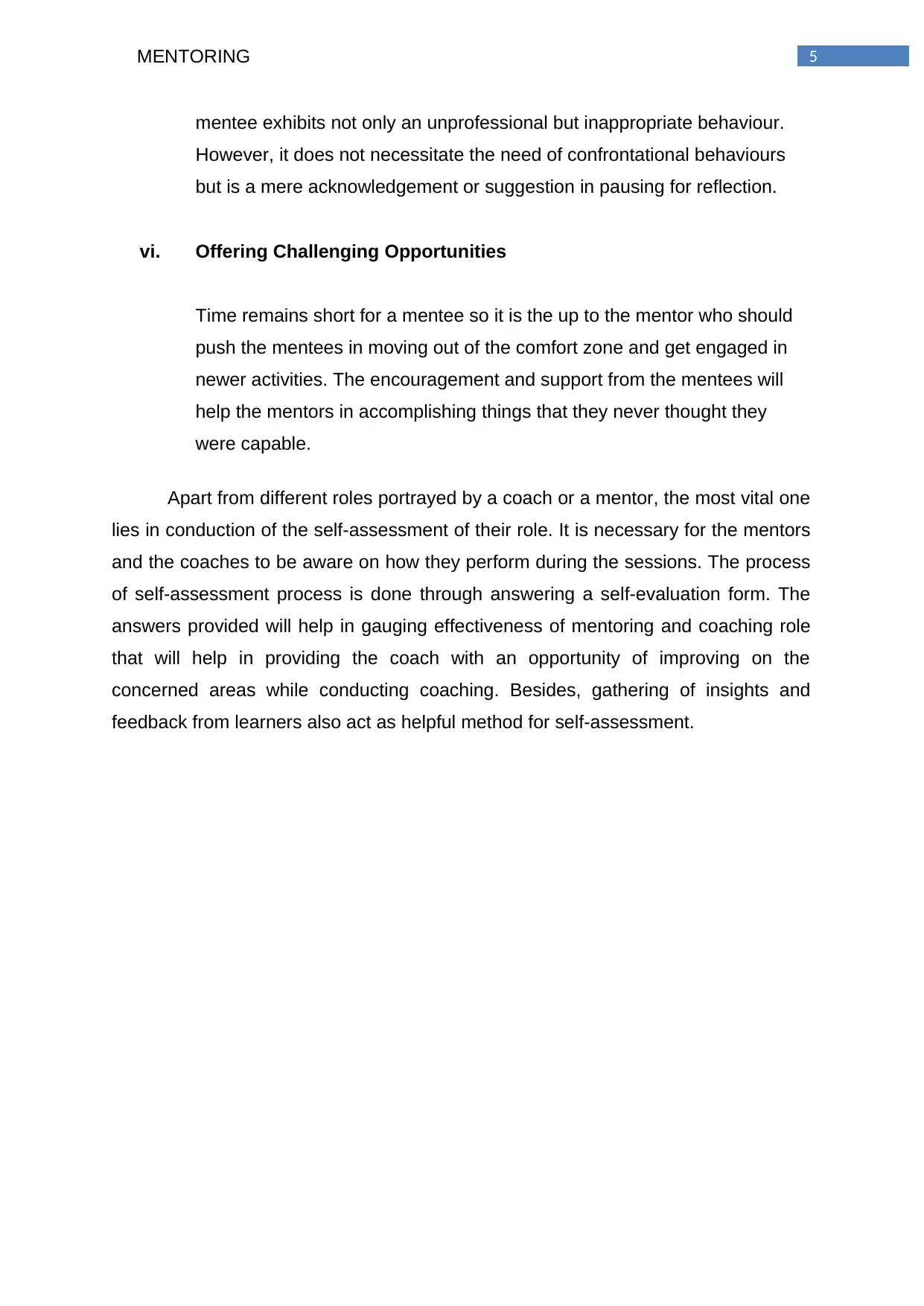
5MENTORING
mentee exhibits not only an unprofessional but inappropriate behaviour.
However, it does not necessitate the need of confrontational behaviours
but is a mere acknowledgement or suggestion in pausing for reflection.
vi. Offering Challenging Opportunities
Time remains short for a mentee so it is the up to the mentor who should
push the mentees in moving out of the comfort zone and get engaged in
newer activities. The encouragement and support from the mentees will
help the mentors in accomplishing things that they never thought they
were capable.
Apart from different roles portrayed by a coach or a mentor, the most vital one
lies in conduction of the self-assessment of their role. It is necessary for the mentors
and the coaches to be aware on how they perform during the sessions. The process
of self-assessment process is done through answering a self-evaluation form. The
answers provided will help in gauging effectiveness of mentoring and coaching role
that will help in providing the coach with an opportunity of improving on the
concerned areas while conducting coaching. Besides, gathering of insights and
feedback from learners also act as helpful method for self-assessment.
mentee exhibits not only an unprofessional but inappropriate behaviour.
However, it does not necessitate the need of confrontational behaviours
but is a mere acknowledgement or suggestion in pausing for reflection.
vi. Offering Challenging Opportunities
Time remains short for a mentee so it is the up to the mentor who should
push the mentees in moving out of the comfort zone and get engaged in
newer activities. The encouragement and support from the mentees will
help the mentors in accomplishing things that they never thought they
were capable.
Apart from different roles portrayed by a coach or a mentor, the most vital one
lies in conduction of the self-assessment of their role. It is necessary for the mentors
and the coaches to be aware on how they perform during the sessions. The process
of self-assessment process is done through answering a self-evaluation form. The
answers provided will help in gauging effectiveness of mentoring and coaching role
that will help in providing the coach with an opportunity of improving on the
concerned areas while conducting coaching. Besides, gathering of insights and
feedback from learners also act as helpful method for self-assessment.
⊘ This is a preview!⊘
Do you want full access?
Subscribe today to unlock all pages.

Trusted by 1+ million students worldwide
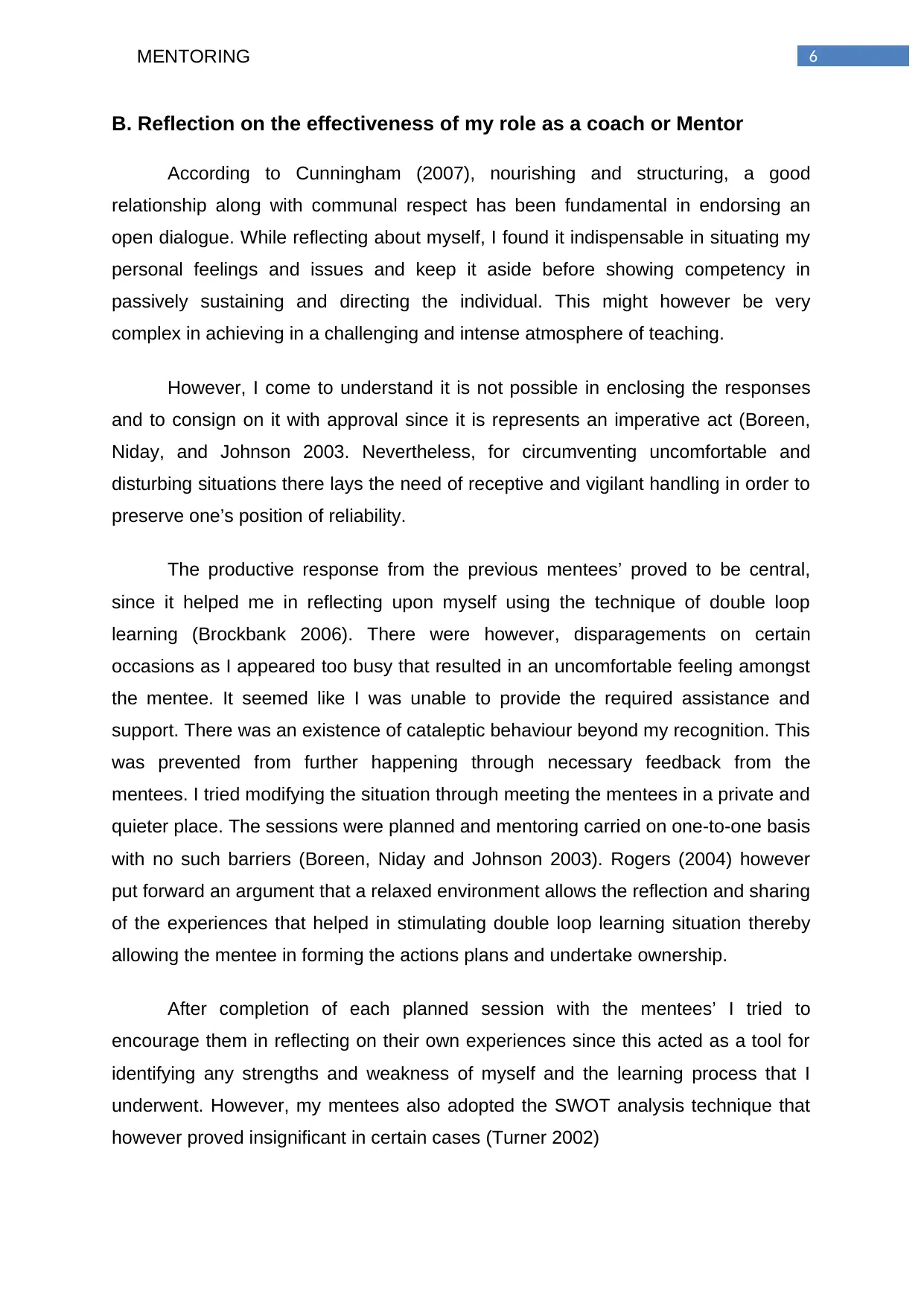
6MENTORING
B. Reflection on the effectiveness of my role as a coach or Mentor
According to Cunningham (2007), nourishing and structuring, a good
relationship along with communal respect has been fundamental in endorsing an
open dialogue. While reflecting about myself, I found it indispensable in situating my
personal feelings and issues and keep it aside before showing competency in
passively sustaining and directing the individual. This might however be very
complex in achieving in a challenging and intense atmosphere of teaching.
However, I come to understand it is not possible in enclosing the responses
and to consign on it with approval since it is represents an imperative act (Boreen,
Niday, and Johnson 2003. Nevertheless, for circumventing uncomfortable and
disturbing situations there lays the need of receptive and vigilant handling in order to
preserve one’s position of reliability.
The productive response from the previous mentees’ proved to be central,
since it helped me in reflecting upon myself using the technique of double loop
learning (Brockbank 2006). There were however, disparagements on certain
occasions as I appeared too busy that resulted in an uncomfortable feeling amongst
the mentee. It seemed like I was unable to provide the required assistance and
support. There was an existence of cataleptic behaviour beyond my recognition. This
was prevented from further happening through necessary feedback from the
mentees. I tried modifying the situation through meeting the mentees in a private and
quieter place. The sessions were planned and mentoring carried on one-to-one basis
with no such barriers (Boreen, Niday and Johnson 2003). Rogers (2004) however
put forward an argument that a relaxed environment allows the reflection and sharing
of the experiences that helped in stimulating double loop learning situation thereby
allowing the mentee in forming the actions plans and undertake ownership.
After completion of each planned session with the mentees’ I tried to
encourage them in reflecting on their own experiences since this acted as a tool for
identifying any strengths and weakness of myself and the learning process that I
underwent. However, my mentees also adopted the SWOT analysis technique that
however proved insignificant in certain cases (Turner 2002)
B. Reflection on the effectiveness of my role as a coach or Mentor
According to Cunningham (2007), nourishing and structuring, a good
relationship along with communal respect has been fundamental in endorsing an
open dialogue. While reflecting about myself, I found it indispensable in situating my
personal feelings and issues and keep it aside before showing competency in
passively sustaining and directing the individual. This might however be very
complex in achieving in a challenging and intense atmosphere of teaching.
However, I come to understand it is not possible in enclosing the responses
and to consign on it with approval since it is represents an imperative act (Boreen,
Niday, and Johnson 2003. Nevertheless, for circumventing uncomfortable and
disturbing situations there lays the need of receptive and vigilant handling in order to
preserve one’s position of reliability.
The productive response from the previous mentees’ proved to be central,
since it helped me in reflecting upon myself using the technique of double loop
learning (Brockbank 2006). There were however, disparagements on certain
occasions as I appeared too busy that resulted in an uncomfortable feeling amongst
the mentee. It seemed like I was unable to provide the required assistance and
support. There was an existence of cataleptic behaviour beyond my recognition. This
was prevented from further happening through necessary feedback from the
mentees. I tried modifying the situation through meeting the mentees in a private and
quieter place. The sessions were planned and mentoring carried on one-to-one basis
with no such barriers (Boreen, Niday and Johnson 2003). Rogers (2004) however
put forward an argument that a relaxed environment allows the reflection and sharing
of the experiences that helped in stimulating double loop learning situation thereby
allowing the mentee in forming the actions plans and undertake ownership.
After completion of each planned session with the mentees’ I tried to
encourage them in reflecting on their own experiences since this acted as a tool for
identifying any strengths and weakness of myself and the learning process that I
underwent. However, my mentees also adopted the SWOT analysis technique that
however proved insignificant in certain cases (Turner 2002)
Paraphrase This Document
Need a fresh take? Get an instant paraphrase of this document with our AI Paraphraser
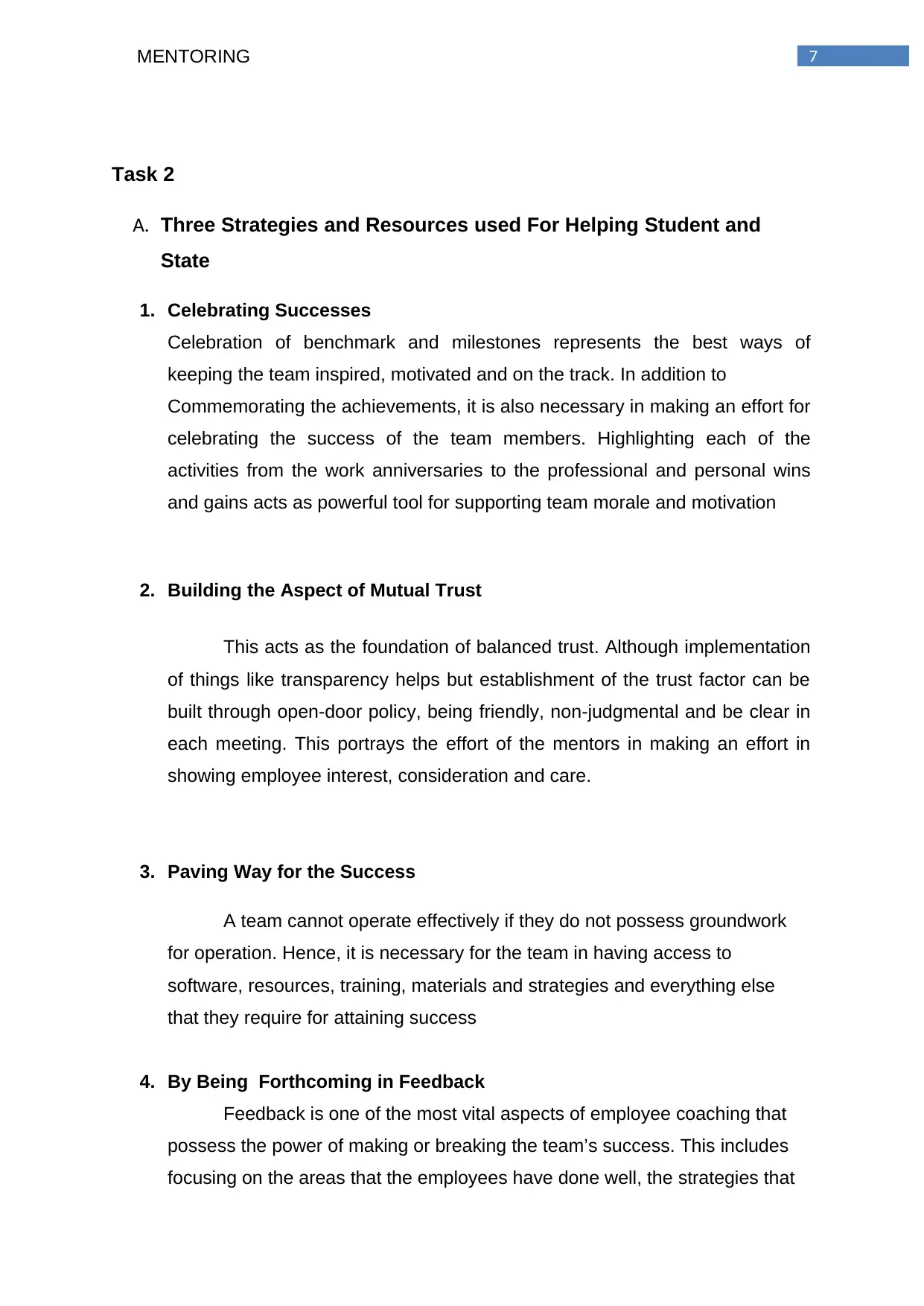
7MENTORING
Task 2
A. Three Strategies and Resources used For Helping Student and
State
1. Celebrating Successes
Celebration of benchmark and milestones represents the best ways of
keeping the team inspired, motivated and on the track. In addition to
Commemorating the achievements, it is also necessary in making an effort for
celebrating the success of the team members. Highlighting each of the
activities from the work anniversaries to the professional and personal wins
and gains acts as powerful tool for supporting team morale and motivation
2. Building the Aspect of Mutual Trust
This acts as the foundation of balanced trust. Although implementation
of things like transparency helps but establishment of the trust factor can be
built through open-door policy, being friendly, non-judgmental and be clear in
each meeting. This portrays the effort of the mentors in making an effort in
showing employee interest, consideration and care.
3. Paving Way for the Success
A team cannot operate effectively if they do not possess groundwork
for operation. Hence, it is necessary for the team in having access to
software, resources, training, materials and strategies and everything else
that they require for attaining success
4. By Being Forthcoming in Feedback
Feedback is one of the most vital aspects of employee coaching that
possess the power of making or breaking the team’s success. This includes
focusing on the areas that the employees have done well, the strategies that
Task 2
A. Three Strategies and Resources used For Helping Student and
State
1. Celebrating Successes
Celebration of benchmark and milestones represents the best ways of
keeping the team inspired, motivated and on the track. In addition to
Commemorating the achievements, it is also necessary in making an effort for
celebrating the success of the team members. Highlighting each of the
activities from the work anniversaries to the professional and personal wins
and gains acts as powerful tool for supporting team morale and motivation
2. Building the Aspect of Mutual Trust
This acts as the foundation of balanced trust. Although implementation
of things like transparency helps but establishment of the trust factor can be
built through open-door policy, being friendly, non-judgmental and be clear in
each meeting. This portrays the effort of the mentors in making an effort in
showing employee interest, consideration and care.
3. Paving Way for the Success
A team cannot operate effectively if they do not possess groundwork
for operation. Hence, it is necessary for the team in having access to
software, resources, training, materials and strategies and everything else
that they require for attaining success
4. By Being Forthcoming in Feedback
Feedback is one of the most vital aspects of employee coaching that
possess the power of making or breaking the team’s success. This includes
focusing on the areas that the employees have done well, the strategies that
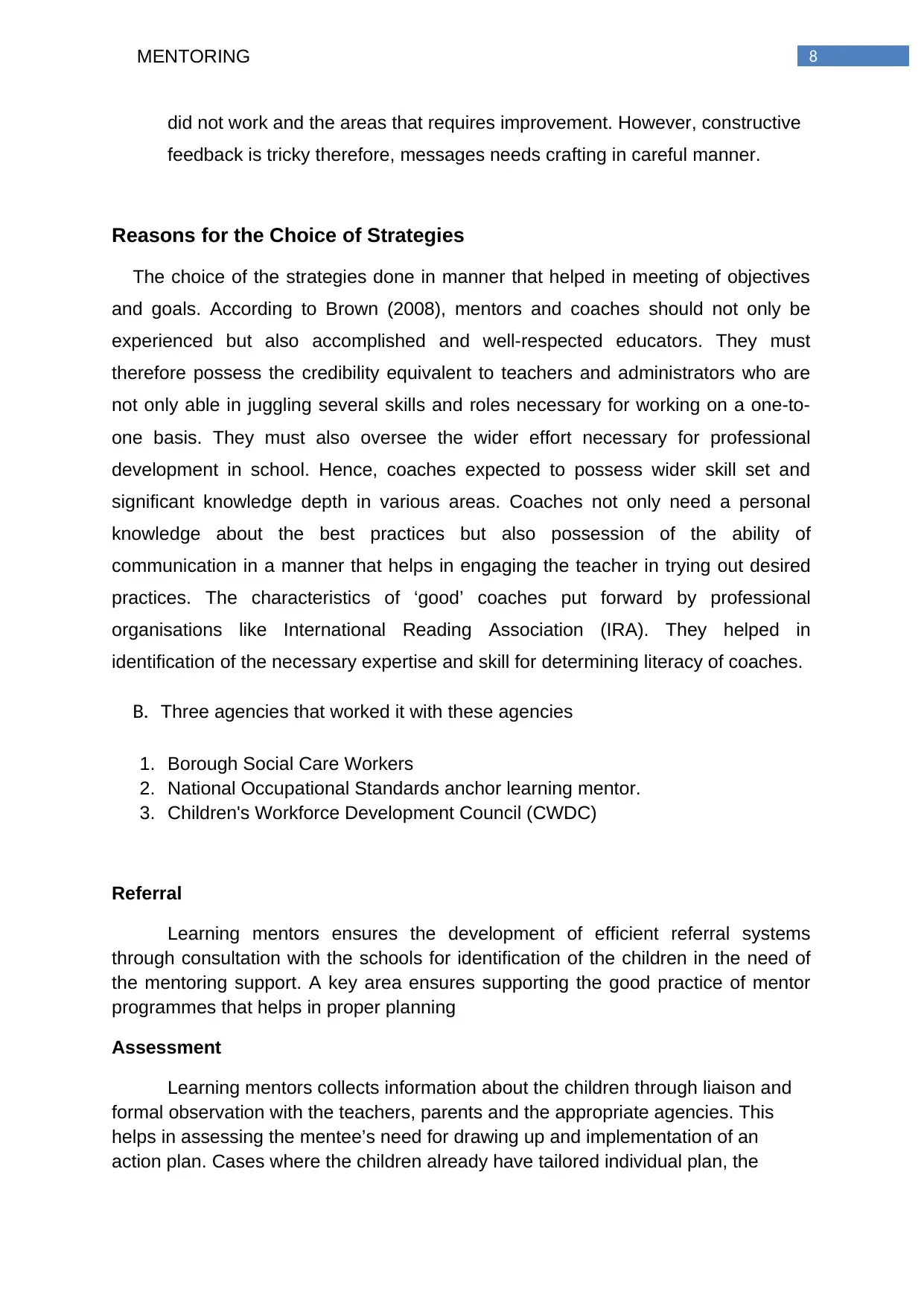
8MENTORING
did not work and the areas that requires improvement. However, constructive
feedback is tricky therefore, messages needs crafting in careful manner.
Reasons for the Choice of Strategies
The choice of the strategies done in manner that helped in meeting of objectives
and goals. According to Brown (2008), mentors and coaches should not only be
experienced but also accomplished and well-respected educators. They must
therefore possess the credibility equivalent to teachers and administrators who are
not only able in juggling several skills and roles necessary for working on a one-to-
one basis. They must also oversee the wider effort necessary for professional
development in school. Hence, coaches expected to possess wider skill set and
significant knowledge depth in various areas. Coaches not only need a personal
knowledge about the best practices but also possession of the ability of
communication in a manner that helps in engaging the teacher in trying out desired
practices. The characteristics of ‘good’ coaches put forward by professional
organisations like International Reading Association (IRA). They helped in
identification of the necessary expertise and skill for determining literacy of coaches.
B. Three agencies that worked it with these agencies
1. Borough Social Care Workers
2. National Occupational Standards anchor learning mentor.
3. Children's Workforce Development Council (CWDC)
Referral
Learning mentors ensures the development of efficient referral systems
through consultation with the schools for identification of the children in the need of
the mentoring support. A key area ensures supporting the good practice of mentor
programmes that helps in proper planning
Assessment
Learning mentors collects information about the children through liaison and
formal observation with the teachers, parents and the appropriate agencies. This
helps in assessing the mentee’s need for drawing up and implementation of an
action plan. Cases where the children already have tailored individual plan, the
did not work and the areas that requires improvement. However, constructive
feedback is tricky therefore, messages needs crafting in careful manner.
Reasons for the Choice of Strategies
The choice of the strategies done in manner that helped in meeting of objectives
and goals. According to Brown (2008), mentors and coaches should not only be
experienced but also accomplished and well-respected educators. They must
therefore possess the credibility equivalent to teachers and administrators who are
not only able in juggling several skills and roles necessary for working on a one-to-
one basis. They must also oversee the wider effort necessary for professional
development in school. Hence, coaches expected to possess wider skill set and
significant knowledge depth in various areas. Coaches not only need a personal
knowledge about the best practices but also possession of the ability of
communication in a manner that helps in engaging the teacher in trying out desired
practices. The characteristics of ‘good’ coaches put forward by professional
organisations like International Reading Association (IRA). They helped in
identification of the necessary expertise and skill for determining literacy of coaches.
B. Three agencies that worked it with these agencies
1. Borough Social Care Workers
2. National Occupational Standards anchor learning mentor.
3. Children's Workforce Development Council (CWDC)
Referral
Learning mentors ensures the development of efficient referral systems
through consultation with the schools for identification of the children in the need of
the mentoring support. A key area ensures supporting the good practice of mentor
programmes that helps in proper planning
Assessment
Learning mentors collects information about the children through liaison and
formal observation with the teachers, parents and the appropriate agencies. This
helps in assessing the mentee’s need for drawing up and implementation of an
action plan. Cases where the children already have tailored individual plan, the
⊘ This is a preview!⊘
Do you want full access?
Subscribe today to unlock all pages.

Trusted by 1+ million students worldwide
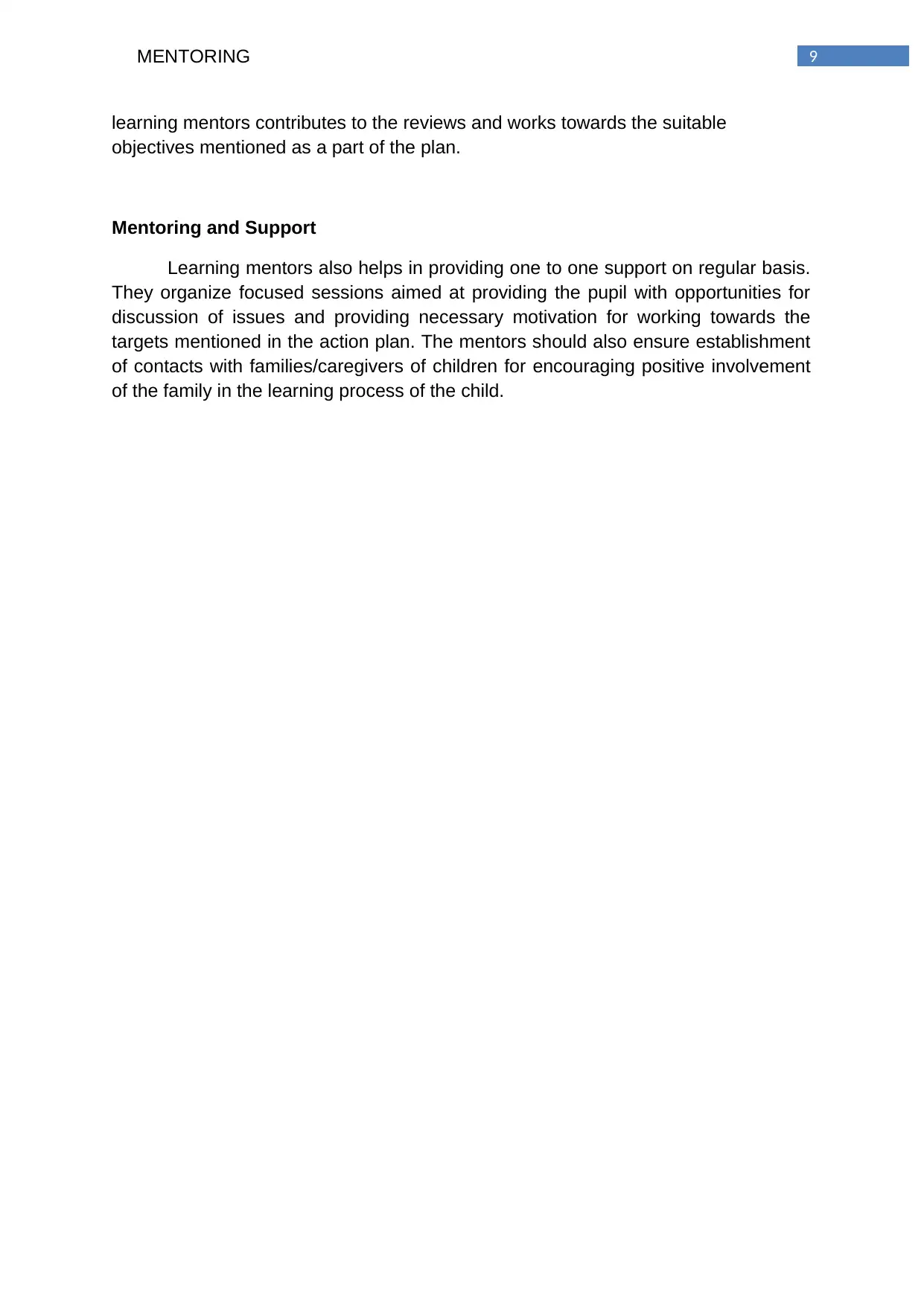
9MENTORING
learning mentors contributes to the reviews and works towards the suitable
objectives mentioned as a part of the plan.
Mentoring and Support
Learning mentors also helps in providing one to one support on regular basis.
They organize focused sessions aimed at providing the pupil with opportunities for
discussion of issues and providing necessary motivation for working towards the
targets mentioned in the action plan. The mentors should also ensure establishment
of contacts with families/caregivers of children for encouraging positive involvement
of the family in the learning process of the child.
learning mentors contributes to the reviews and works towards the suitable
objectives mentioned as a part of the plan.
Mentoring and Support
Learning mentors also helps in providing one to one support on regular basis.
They organize focused sessions aimed at providing the pupil with opportunities for
discussion of issues and providing necessary motivation for working towards the
targets mentioned in the action plan. The mentors should also ensure establishment
of contacts with families/caregivers of children for encouraging positive involvement
of the family in the learning process of the child.
Paraphrase This Document
Need a fresh take? Get an instant paraphrase of this document with our AI Paraphraser
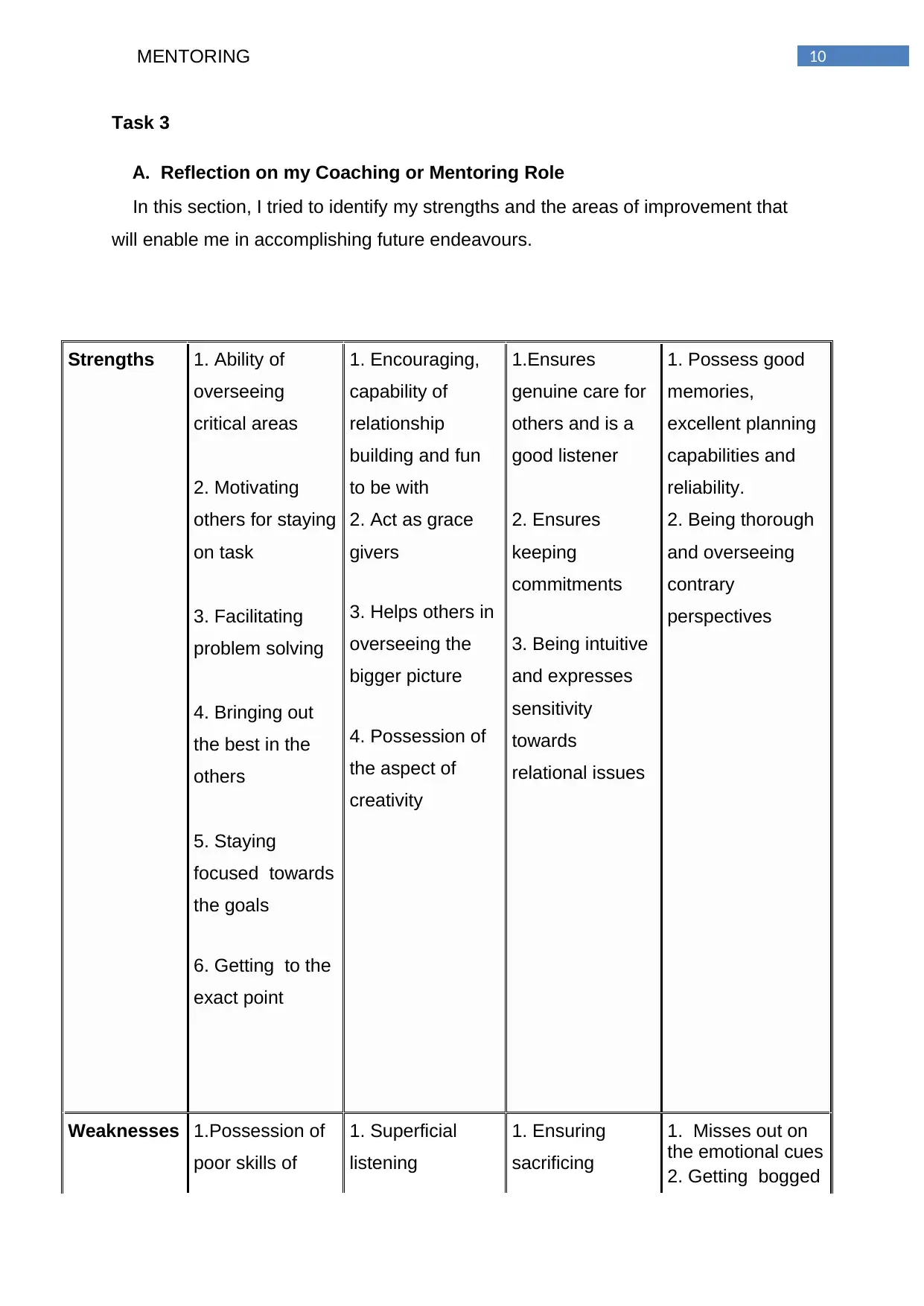
10MENTORING
Task 3
A. Reflection on my Coaching or Mentoring Role
In this section, I tried to identify my strengths and the areas of improvement that
will enable me in accomplishing future endeavours.
Strengths 1. Ability of
overseeing
critical areas
2. Motivating
others for staying
on task
3. Facilitating
problem solving
4. Bringing out
the best in the
others
5. Staying
focused towards
the goals
6. Getting to the
exact point
1. Encouraging,
capability of
relationship
building and fun
to be with
2. Act as grace
givers
3. Helps others in
overseeing the
bigger picture
4. Possession of
the aspect of
creativity
1.Ensures
genuine care for
others and is a
good listener
2. Ensures
keeping
commitments
3. Being intuitive
and expresses
sensitivity
towards
relational issues
1. Possess good
memories,
excellent planning
capabilities and
reliability.
2. Being thorough
and overseeing
contrary
perspectives
Weaknesses 1.Possession of
poor skills of
1. Superficial
listening
1. Ensuring
sacrificing
1. Misses out on
the emotional cues
2. Getting bogged
Task 3
A. Reflection on my Coaching or Mentoring Role
In this section, I tried to identify my strengths and the areas of improvement that
will enable me in accomplishing future endeavours.
Strengths 1. Ability of
overseeing
critical areas
2. Motivating
others for staying
on task
3. Facilitating
problem solving
4. Bringing out
the best in the
others
5. Staying
focused towards
the goals
6. Getting to the
exact point
1. Encouraging,
capability of
relationship
building and fun
to be with
2. Act as grace
givers
3. Helps others in
overseeing the
bigger picture
4. Possession of
the aspect of
creativity
1.Ensures
genuine care for
others and is a
good listener
2. Ensures
keeping
commitments
3. Being intuitive
and expresses
sensitivity
towards
relational issues
1. Possess good
memories,
excellent planning
capabilities and
reliability.
2. Being thorough
and overseeing
contrary
perspectives
Weaknesses 1.Possession of
poor skills of
1. Superficial
listening
1. Ensuring
sacrificing
1. Misses out on
the emotional cues
2. Getting bogged
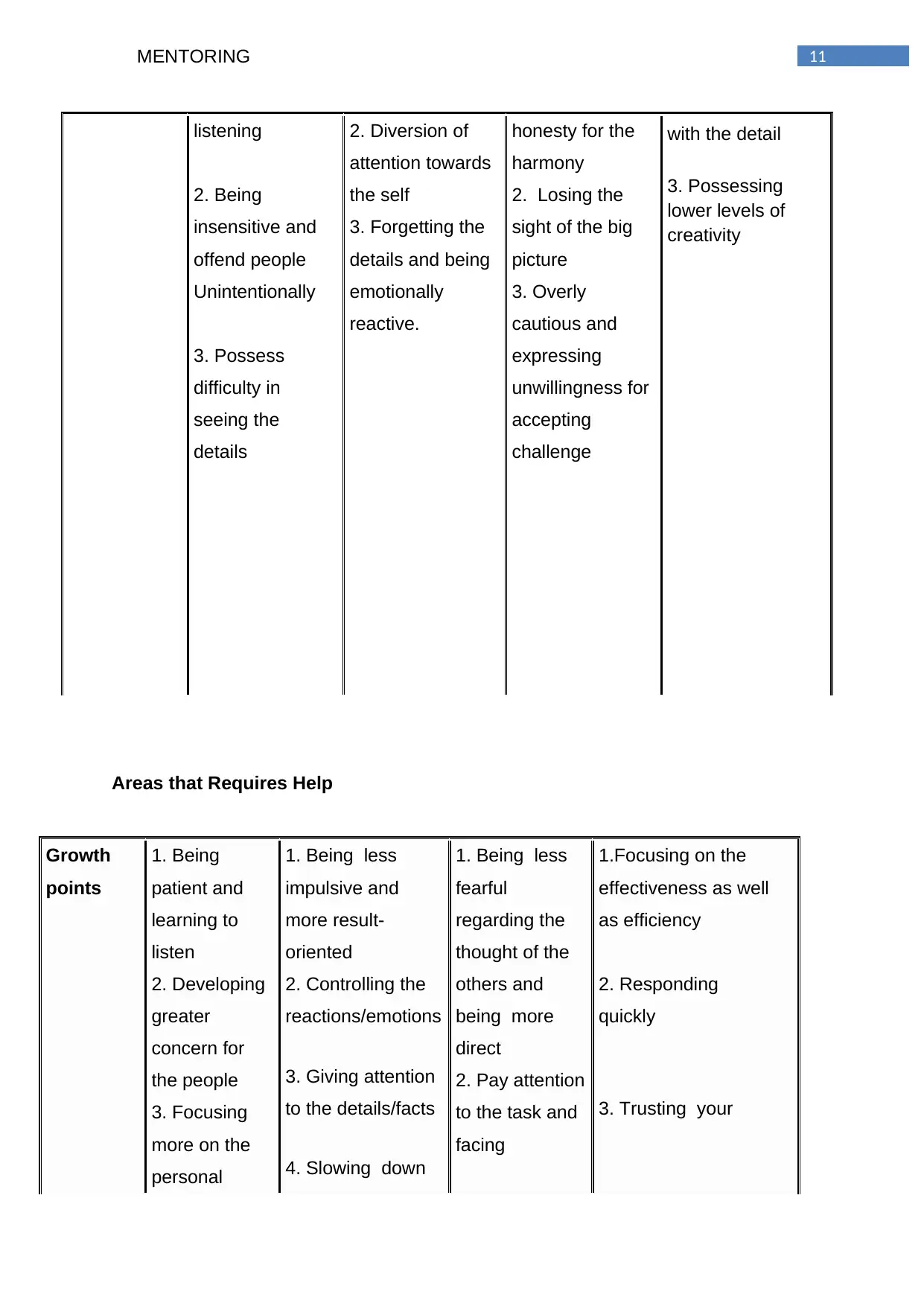
11MENTORING
listening
2. Being
insensitive and
offend people
Unintentionally
3. Possess
difficulty in
seeing the
details
2. Diversion of
attention towards
the self
3. Forgetting the
details and being
emotionally
reactive.
honesty for the
harmony
2. Losing the
sight of the big
picture
3. Overly
cautious and
expressing
unwillingness for
accepting
challenge
with the detail
3. Possessing
lower levels of
creativity
Areas that Requires Help
Growth
points
1. Being
patient and
learning to
listen
2. Developing
greater
concern for
the people
3. Focusing
more on the
personal
1. Being less
impulsive and
more result-
oriented
2. Controlling the
reactions/emotions
3. Giving attention
to the details/facts
4. Slowing down
1. Being less
fearful
regarding the
thought of the
others and
being more
direct
2. Pay attention
to the task and
facing
1.Focusing on the
effectiveness as well
as efficiency
2. Responding
quickly
3. Trusting your
listening
2. Being
insensitive and
offend people
Unintentionally
3. Possess
difficulty in
seeing the
details
2. Diversion of
attention towards
the self
3. Forgetting the
details and being
emotionally
reactive.
honesty for the
harmony
2. Losing the
sight of the big
picture
3. Overly
cautious and
expressing
unwillingness for
accepting
challenge
with the detail
3. Possessing
lower levels of
creativity
Areas that Requires Help
Growth
points
1. Being
patient and
learning to
listen
2. Developing
greater
concern for
the people
3. Focusing
more on the
personal
1. Being less
impulsive and
more result-
oriented
2. Controlling the
reactions/emotions
3. Giving attention
to the details/facts
4. Slowing down
1. Being less
fearful
regarding the
thought of the
others and
being more
direct
2. Pay attention
to the task and
facing
1.Focusing on the
effectiveness as well
as efficiency
2. Responding
quickly
3. Trusting your
⊘ This is a preview!⊘
Do you want full access?
Subscribe today to unlock all pages.

Trusted by 1+ million students worldwide
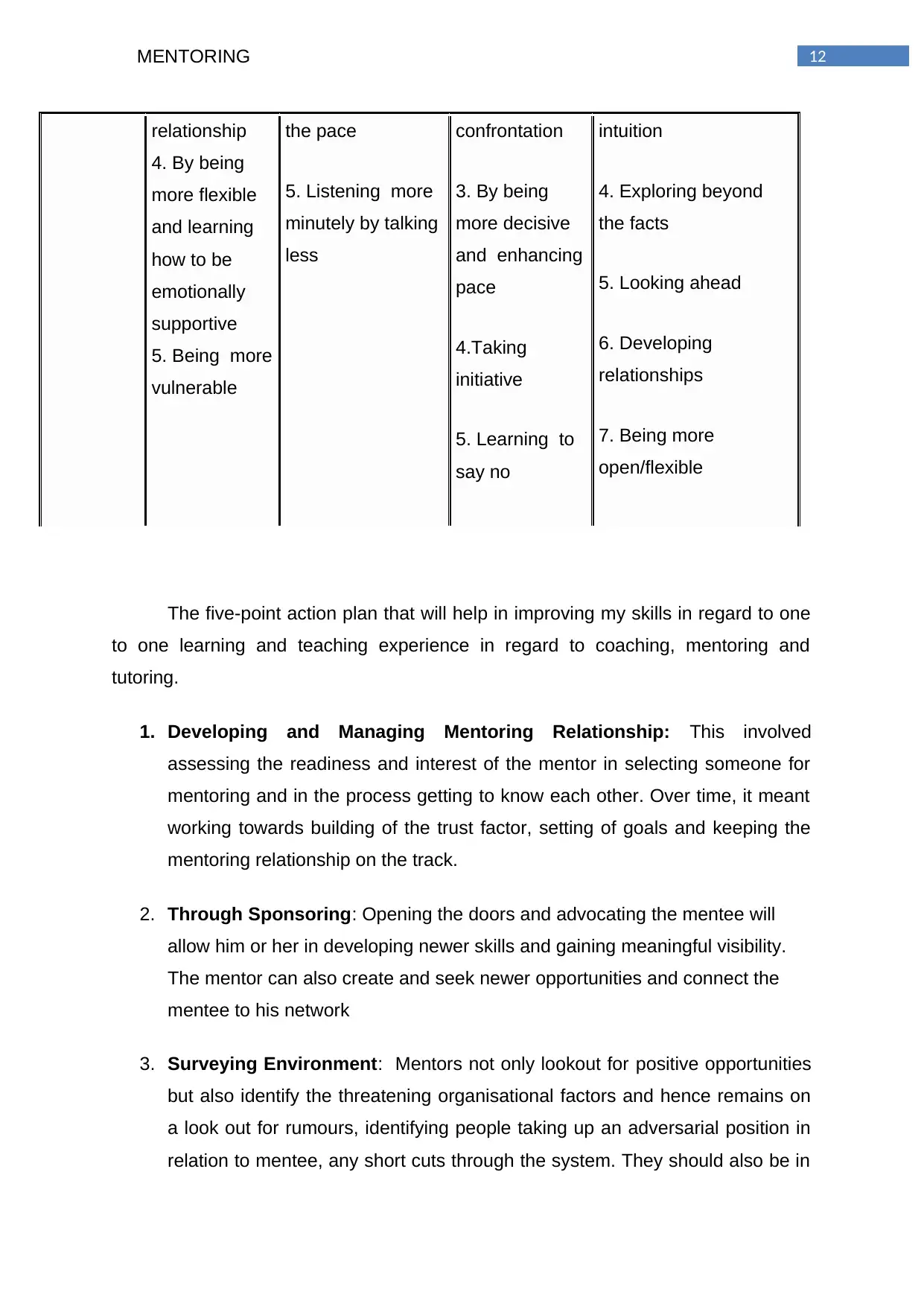
12MENTORING
relationship
4. By being
more flexible
and learning
how to be
emotionally
supportive
5. Being more
vulnerable
the pace
5. Listening more
minutely by talking
less
confrontation
3. By being
more decisive
and enhancing
pace
4.Taking
initiative
5. Learning to
say no
intuition
4. Exploring beyond
the facts
5. Looking ahead
6. Developing
relationships
7. Being more
open/flexible
The five-point action plan that will help in improving my skills in regard to one
to one learning and teaching experience in regard to coaching, mentoring and
tutoring.
1. Developing and Managing Mentoring Relationship: This involved
assessing the readiness and interest of the mentor in selecting someone for
mentoring and in the process getting to know each other. Over time, it meant
working towards building of the trust factor, setting of goals and keeping the
mentoring relationship on the track.
2. Through Sponsoring: Opening the doors and advocating the mentee will
allow him or her in developing newer skills and gaining meaningful visibility.
The mentor can also create and seek newer opportunities and connect the
mentee to his network
3. Surveying Environment: Mentors not only lookout for positive opportunities
but also identify the threatening organisational factors and hence remains on
a look out for rumours, identifying people taking up an adversarial position in
relation to mentee, any short cuts through the system. They should also be in
relationship
4. By being
more flexible
and learning
how to be
emotionally
supportive
5. Being more
vulnerable
the pace
5. Listening more
minutely by talking
less
confrontation
3. By being
more decisive
and enhancing
pace
4.Taking
initiative
5. Learning to
say no
intuition
4. Exploring beyond
the facts
5. Looking ahead
6. Developing
relationships
7. Being more
open/flexible
The five-point action plan that will help in improving my skills in regard to one
to one learning and teaching experience in regard to coaching, mentoring and
tutoring.
1. Developing and Managing Mentoring Relationship: This involved
assessing the readiness and interest of the mentor in selecting someone for
mentoring and in the process getting to know each other. Over time, it meant
working towards building of the trust factor, setting of goals and keeping the
mentoring relationship on the track.
2. Through Sponsoring: Opening the doors and advocating the mentee will
allow him or her in developing newer skills and gaining meaningful visibility.
The mentor can also create and seek newer opportunities and connect the
mentee to his network
3. Surveying Environment: Mentors not only lookout for positive opportunities
but also identify the threatening organisational factors and hence remains on
a look out for rumours, identifying people taking up an adversarial position in
relation to mentee, any short cuts through the system. They should also be in
Paraphrase This Document
Need a fresh take? Get an instant paraphrase of this document with our AI Paraphraser
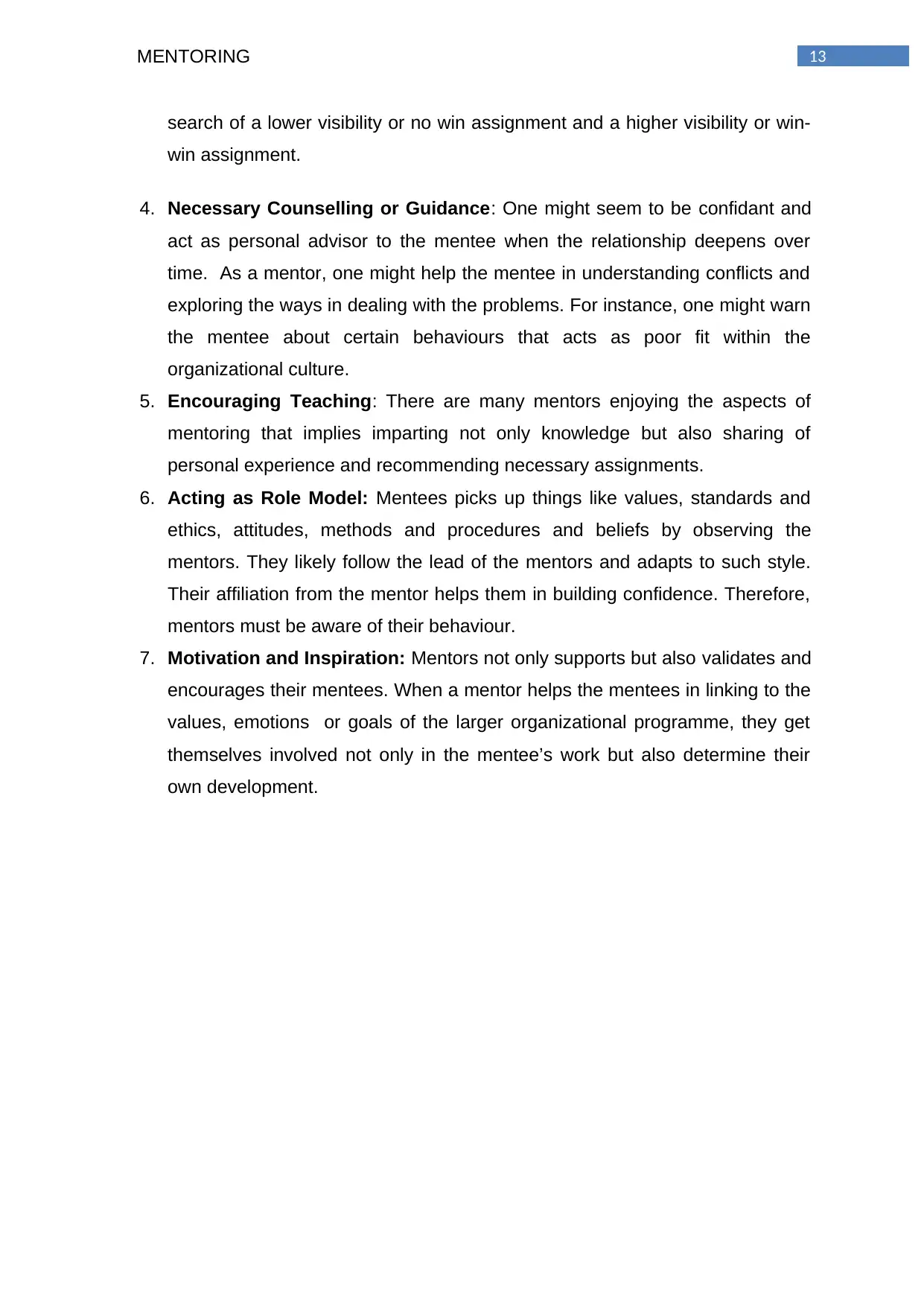
13MENTORING
search of a lower visibility or no win assignment and a higher visibility or win-
win assignment.
4. Necessary Counselling or Guidance: One might seem to be confidant and
act as personal advisor to the mentee when the relationship deepens over
time. As a mentor, one might help the mentee in understanding conflicts and
exploring the ways in dealing with the problems. For instance, one might warn
the mentee about certain behaviours that acts as poor fit within the
organizational culture.
5. Encouraging Teaching: There are many mentors enjoying the aspects of
mentoring that implies imparting not only knowledge but also sharing of
personal experience and recommending necessary assignments.
6. Acting as Role Model: Mentees picks up things like values, standards and
ethics, attitudes, methods and procedures and beliefs by observing the
mentors. They likely follow the lead of the mentors and adapts to such style.
Their affiliation from the mentor helps them in building confidence. Therefore,
mentors must be aware of their behaviour.
7. Motivation and Inspiration: Mentors not only supports but also validates and
encourages their mentees. When a mentor helps the mentees in linking to the
values, emotions or goals of the larger organizational programme, they get
themselves involved not only in the mentee’s work but also determine their
own development.
search of a lower visibility or no win assignment and a higher visibility or win-
win assignment.
4. Necessary Counselling or Guidance: One might seem to be confidant and
act as personal advisor to the mentee when the relationship deepens over
time. As a mentor, one might help the mentee in understanding conflicts and
exploring the ways in dealing with the problems. For instance, one might warn
the mentee about certain behaviours that acts as poor fit within the
organizational culture.
5. Encouraging Teaching: There are many mentors enjoying the aspects of
mentoring that implies imparting not only knowledge but also sharing of
personal experience and recommending necessary assignments.
6. Acting as Role Model: Mentees picks up things like values, standards and
ethics, attitudes, methods and procedures and beliefs by observing the
mentors. They likely follow the lead of the mentors and adapts to such style.
Their affiliation from the mentor helps them in building confidence. Therefore,
mentors must be aware of their behaviour.
7. Motivation and Inspiration: Mentors not only supports but also validates and
encourages their mentees. When a mentor helps the mentees in linking to the
values, emotions or goals of the larger organizational programme, they get
themselves involved not only in the mentee’s work but also determine their
own development.
1 out of 14
Related Documents
Your All-in-One AI-Powered Toolkit for Academic Success.
+13062052269
info@desklib.com
Available 24*7 on WhatsApp / Email
![[object Object]](/_next/static/media/star-bottom.7253800d.svg)
Unlock your academic potential
© 2024 | Zucol Services PVT LTD | All rights reserved.




